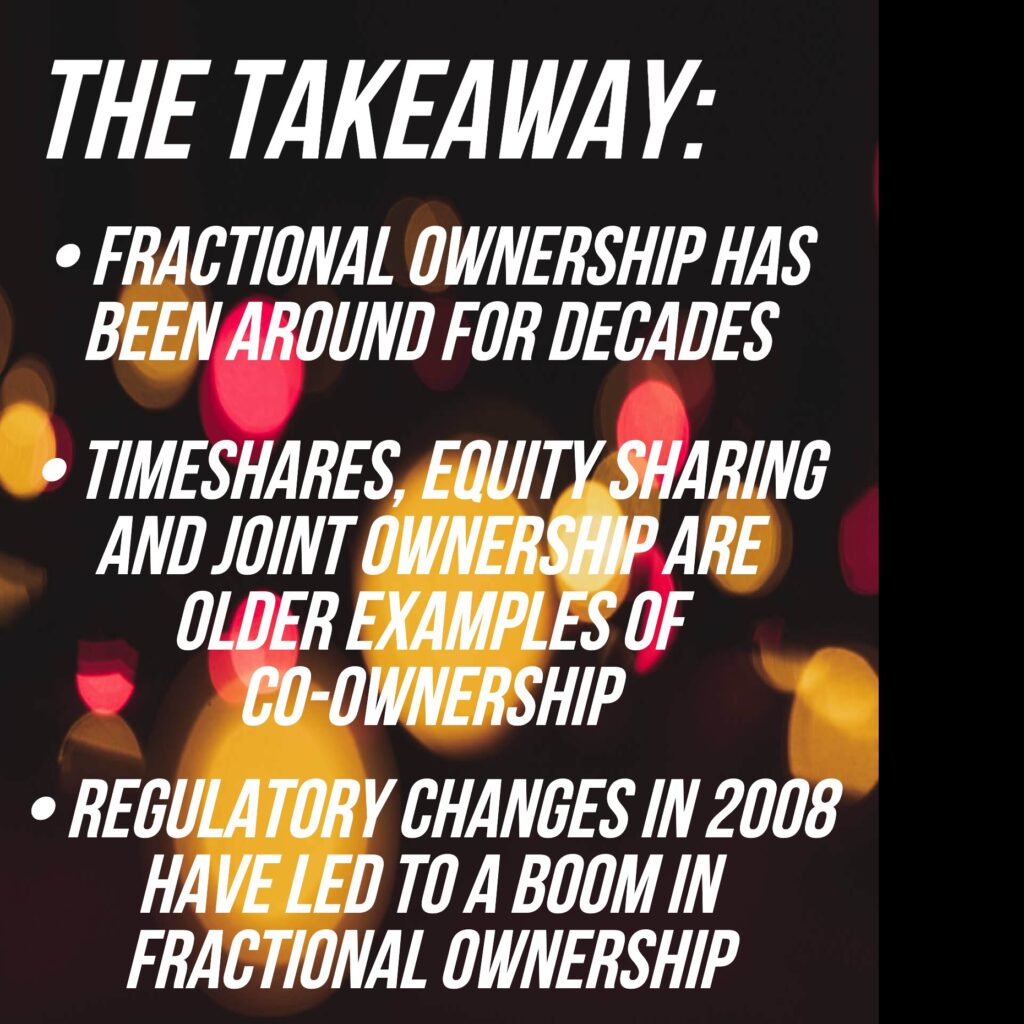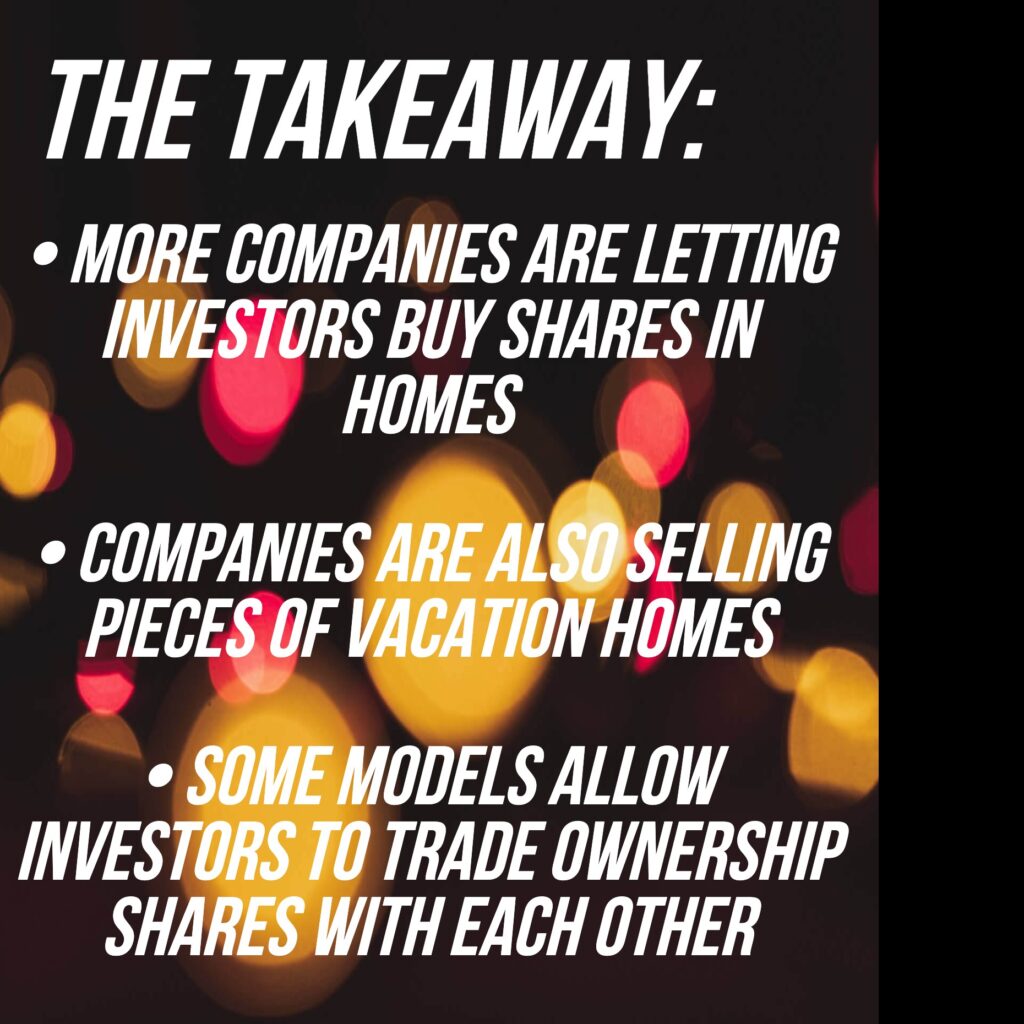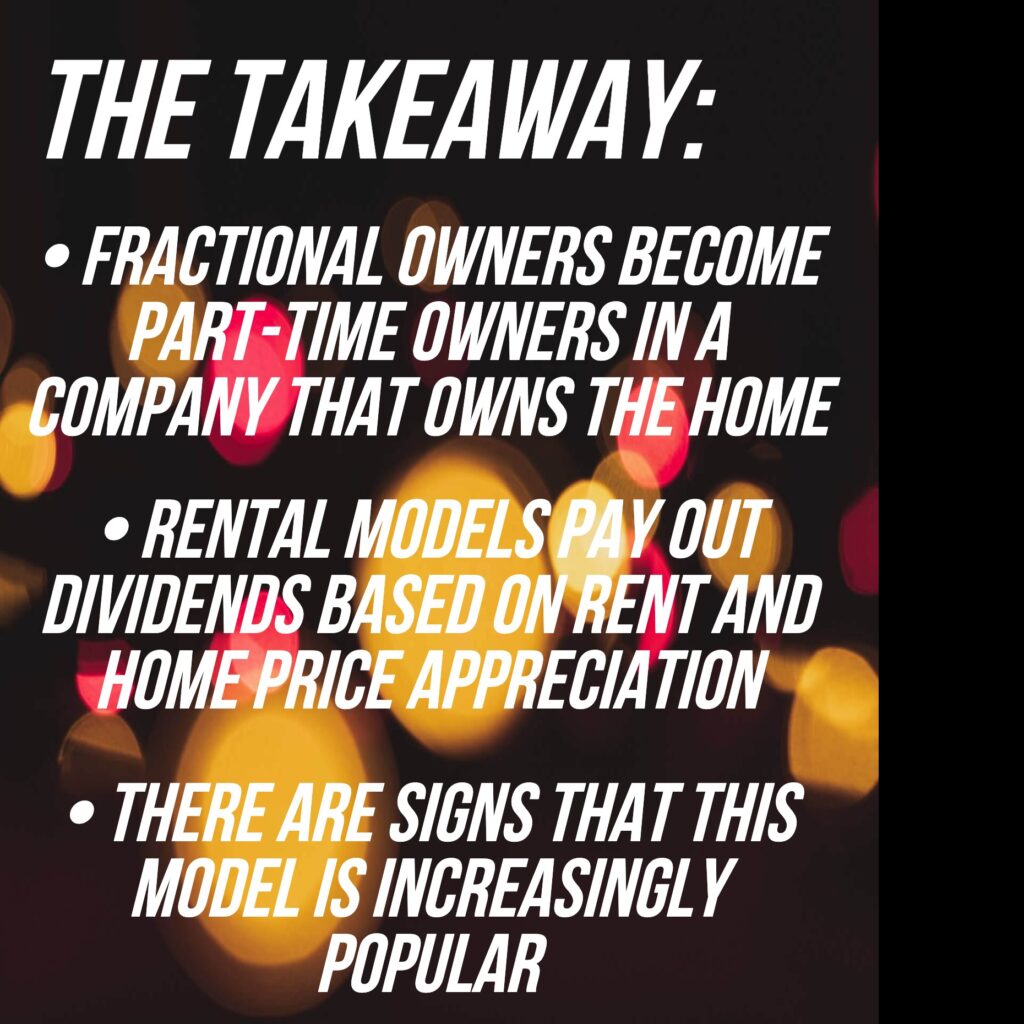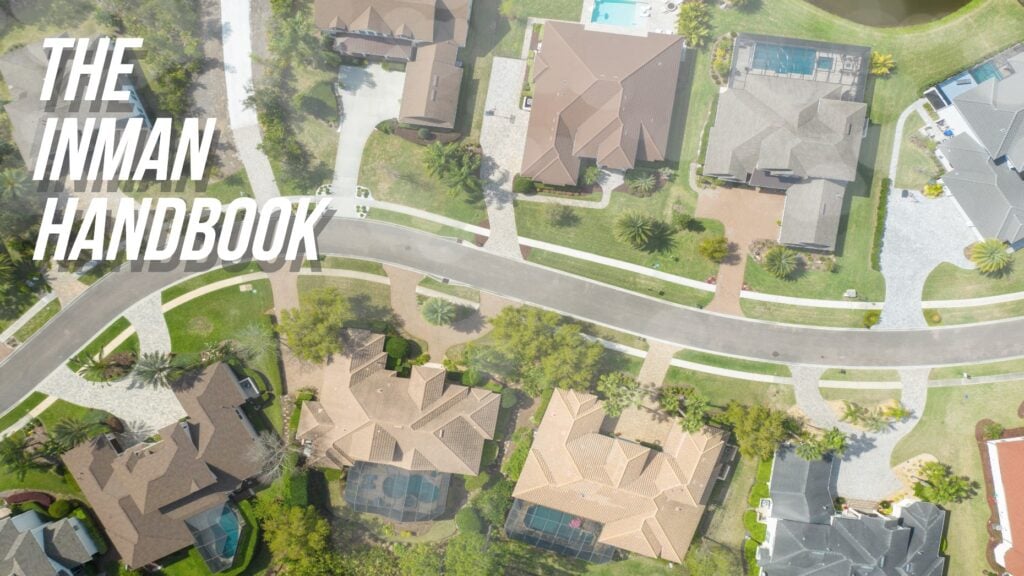At Inman Disconnect in March, a gathering of industry leaders was assigned with making predictions for the future of real estate when a theme emerged.
“You can co-own — short-term rentals and long-term rentals,” one attendee said at the off-the-record event. “Whether you’re buying, renting, whatever, it is going to be irrelevant.”
The executives foretold of a future when small-time investors or buyers, unable to purchase entire homes, would move toward buying real estate in groups. Call it fractional homeownership, and a few recent examples may show that the future is already here.
“The basic idea is to open up real estate investment opportunities to a wider audience, meaning not just very rich people,” said Andy Sirkin, principal attorney at SirkinLaw, who specializes in co-homeownership.
Modern fractional real estate ownership can involve friends and family pooling resources to buy homes. This has become a way for some to compete in the highly competitive post-COVID real estate market, which has featured intense competition, high prices and the perception of scarce inventory, caused by record-fast home sales.
If it seems like a far-fetched prediction from industry royals, consider the experience in May of fractional ownership start-up Arrived Homes.
The company was founded as a marketplace for small-time investors to buy shares in rental homes for as little as $100. Those co-owners earn dividends from rent and price appreciation on the homes they buy into.
In early May, the company announced it would release more than a dozen homes worth over $4 million. Investors could buy shares of the homes, becoming part-owners of the real estate asset. Arrived then acts as property management company, placing tenants, taking care of maintenance, and paying co-owners dividends earned by rent and appreciation of the homes.
When the homes were opened up to investors, the rush of demand was 100 times more than any previous release, crashing the platform that’s backed by Amazon founder Jeff Bezos. When the glitches were fixed a few hours later, every home was sold out.
More than a bad bit of public relations for the start-up, the botched roll-out was proof of concept.
Ross Hair | Broker, Mille Real Estate
“It’s all going to move that way,” said Ross Hair, a broker at Mille Real Estate in Boulder, Colorado. “Think about what they’re doing: You can get on Arrived, you push a button and you own a real estate asset.”
This represents just one of several models for real estate investors to explore, depending on their personal financial goals. Inman recently spoke to industry professionals to try to explain the state of modern fractional homeownership. Here’s what they had to say:
Table of Contents
Evolution of fractional ownership
Sirkin says new companies like Arrived and Pacaso, which sells shares of high-end vacation rentals to co-owners, are only the latest version of something that’s been around for decades.
“Starting in the late 80s, early 90s, we got involved in a lot of vacation home sharing arrangements — kind of timeshares but writ small, only involving a single home,” Sirkin said. “That market has continued to develop strongly on the internet.”
In markets all over the world, high-end homes are being sold an eighth at a time to buyers who are getting access to vacation homes for several weeks out of the year.
No, these aren’t timeshares, they’re homes by companies like Pacaso and Ember, which sell shares in luxury homes to people looking for an ownership stake in destination markets, where they can spend more than a week or two a year.
This model represents one facet of the modern age of fractional homeownership, a move past traditional timeshares and into something new.
“The most important difference is the size of the group and the size of the property involved,” said Sirkin, whose firm has helped arrange all different types of fractional ownership arrangements over the past three decades.
“Historically the word timeshare has been used to describe resort-like complexes — complexes that involve more than a single home, and the number of users or owners per home was relatively large,” Sirkin said.
It can also include companies buying homes and then reselling pieces of them online, oftentimes using the blockchain or tokenization to track ownership.
“In the last five years or so we’ve gotten involved in more and more start-ups,” Sirkin said. “Some of these are equity sharing. Others are more investment syndication — people profiting from the operation of a home or a group of homes as they’re used for rental purposes.”
Whereas there were previously options for accredited investors — very wealthy traders, banks and trusts — the regulations around trading prevented options other than lower-yield real estate investment trusts (REITs).
“If you didn’t want to buy into a relatively low-return, massive REIT you had to be a rich person,” Sirkin said. “One idea that’s arisen since 2008…is: why is that?”
“Why can a relatively modest means person buy a share of stock but not buy any interest in real estate?” he added. “During the Obama years when they did securities reform in 2008, one of the things they did was introduce the idea that there should be a crowdfunding exemption to the securities laws.”
And thus, modern fractional homeownership was born.

Types of co-ownership
A common type of fractional ownership historically has been investing in a REIT, which typically own, operate or finance income-producing real estate.

G. Brian Davis | Co-founder, Spark Rental
People have been able to invest in REITs through mutual funds and wait for returns through dividends.
But modern fractional ownership offers small-time and part-time investors the opportunity to buy into individual properties, in effect making them fractional landlords.
“Fractional ownership of rental properties is a pretty new thing in the market,” said G. Brian Davis, an independent investor and owner of Spark Rental. “At least available to your average, non-accredited investor.”
Single-family equity ownership
Groundfloor, Fundrise and Arrived Homes are examples of companies that let investors buy portions of single-family rental homes for however much money they have to invest.

Ryan Frazier | CEO, Arrived Homes
“Being able to take an ownership stake in that house — but without a lot of the upfront cost, the personal liability for the tenants, the debt — we can make it an easier process,” said Ryan Frazier, co-founder and CEO of Arrived Homes.
In addition to Bezos, Arrived is backed by former Zillow CEO Spencer Rascoff. Those investments help Arrived find new properties in markets across the country.
The company searches for homes where zoning regulations and other factors make it difficult for builders to add supply, which can result in “a strong tailwind for real estate values,” officials at Arrived told prospective investors.
The company is looking at creating a secondary market for investors to sell and trade shares among each other, making the investments even more liquid.
And it’s won the attention of independent investors.
“The ability to just buy like that is phenomenal — no credit, no appraisal, no waiting to see if your offer is accepted, none of that stuff,” said Hair. “None of the work on the back end, either. If you’ve got the money, you just put your money up.”
Splitting second homeownership
A new crop of companies has begun to modernize the vacation home co-ownership space, with a handful of companies selling off portions of high-end homes in destination markets and handling the management between the new co-owners.
The companies — including Pacaso and Ember — say their model differs from timeshares because a stake in a single-family vacation home can be sold in partnership with a real estate agent. The homes are unique, not the condos or resort buildings typically sold in timeshare models.
Buyers are also owners in the real estate asset, rather than pre-paying for time at a resort that’s common in timeshare models.
Publicly-traded buildings
On Pike Street in Seattle’s popular Capitol Hill neighborhood, there sits a new, 45-unit mixed-use building that’s valued at $33 million.
The building known as SOLIS, is a leased-out, six-story building totaling 34,260 rentable square feet. And while it will provide housing for dozens of people, it is also an asset that will be owned by hundreds of people through shares that can be traded, like stocks, through a company called LEX Markets.
“Basically individual investors can purchase an equity share of a single commercial real estate asset,” said Monica Swinney, chief operating officer of LEX. “Those shares are true equity shares. The majority owner still retains majority ownership.”

Monica Swinney | COO, LEX Markets
LEX takes buildings public, turning them into a security and allowing investors to buy shares. There are no requirements that investors be professional investors.
It is one of the new arrivals on the fractional ownership market giving small-time investors the ability to generate wealth through real estate.
LEX has three publicly traded buildings, a parking garage in Maine, an office building in New York City and the Seattle mixed-use building. A warehouse in New Hampshire has yet to begin trading.
Swinney says the model has appeal for people looking to diversify their personal investment portfolios by relying on real estate, and also for the building’s owners to tap some capital while retaining a majority stake in ownership.
“Investors who purchase shares through LEX are entitled to distributions at the same rate as majority owners,” she said. “This asset class has been very limited. Most investors are not able to purchase, to really buy in and have an ownership stake.”
LEX is a commercial real estate version of an equity-sharing model of fractional ownership.

How does this work, exactly?
Investors in models, such as Arrived and Pacaso aren’t exactly buying homes, they’re becoming business partners. That status is what unlocks the front door.
Like Arrived, Pacaso creates a limited liability corporation which allows it to sell off shares of the home, effectively making investors co-owners in a business that owns a home.
“That series LLC structure that they’ve set up is brilliant, by the way,” says Hair.
Pacaso says, owners shouldn’t buy into the business expecting a profit (although that’s always a possibility). They can’t, for instance, rent out their share in the home.
Arrived and LEX, on the other hand, generate their dividends through that rental income, as well as through price appreciation.
Those dividends can earn investors up to 10 percent a year between appreciation and rent. So at a time when the major stock market indices are having their worst performance in years, fractional homeownership appears to be emerging as a potential safe spot to invest.
“For me it fills the role that bonds might fill in someone else’s portfolio,” said Davis. “I personally hate bonds. I think they’re a terrible investment and offer no protection in terms of inflation. You can get that stability in real estate.”
Arrived released another batch of homes to investors in late May, weeks after promising to improve the investor experience under the heavy weight of demand.
This round, six homes valued at more than $1.7 million were opened up for investors who, again, crashed the site due to heavy demand. The homes were sold out within eight minutes.

How to get started
Whether you’re a small-time investor looking to diversify your personal portfolio, or you’re looking for a slice of your next vacation property, you might be wondering how to get going.
Given many of these companies are tech-focused and just a few years old at most, their sites are set up for an easy user experience.
Groundfloor, Fundrise and Arrived Homes allow users to set up a new account and browse available properties within minutes. They all have mailing lists that alert would-be investors to new opportunities.
Pacaso and Ember, too, let people browse available homes and associated costs of fractional ownership whether or not they buy.
Additional resources:
Email Taylor Anderson



 Are You Interested in West Eleventh Residences Miami?
Are You Interested in West Eleventh Residences Miami? Are You Interested in ONE Park Tower by Turnberry?
Are You Interested in ONE Park Tower by Turnberry? Are You Interested in Diesel Wynwood Condominium?
Are You Interested in Diesel Wynwood Condominium? Are You Interested in Five Park Miami Beach?
Are You Interested in Five Park Miami Beach? Are You Interested in Cipriani Residences Miami?
Are You Interested in Cipriani Residences Miami? Are You Interested in Bentley Residences Miami?
Are You Interested in Bentley Residences Miami? Are You Interested in Baccarat Residences Brickell?
Are You Interested in Baccarat Residences Brickell? Are You Interested in Aria Reserve Miami?
Are You Interested in Aria Reserve Miami? Are You Interested in 888 Brickell Dolce & Gabbana | Miami?
Are You Interested in 888 Brickell Dolce & Gabbana | Miami? Are You Interested in 600 Miami WorldCenter?
Are You Interested in 600 Miami WorldCenter? Are You Interested in HUB MIAMI RESIDENCES?
Are You Interested in HUB MIAMI RESIDENCES? Are You Interested in WALDORF ASTORIA RESIDENCES?
Are You Interested in WALDORF ASTORIA RESIDENCES?